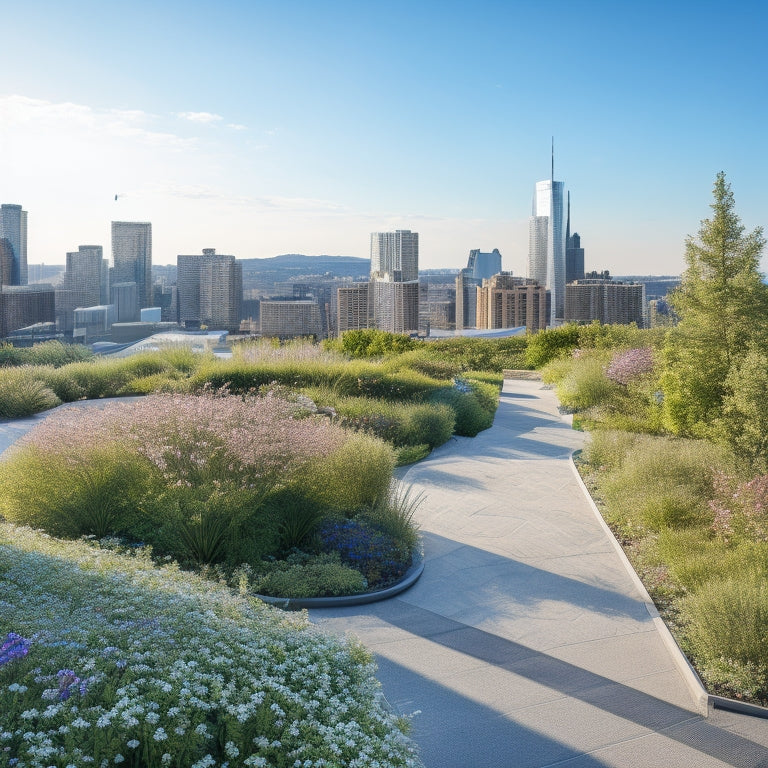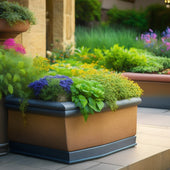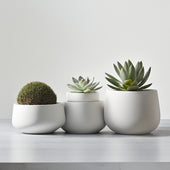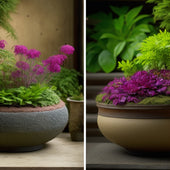
Green Roof Construction: Average Cost Per Square Foot
Share
You can expect to pay between $10 and $30 per square foot for a green roof, depending on the complexity of the design, materials used, and local labor costs. Factors like waterproofing, insulation, drainage, and vegetation choices all influence the final cost. To get a more accurate estimate, consider the specific needs of your project, such as the load-bearing capacity and local climate. Keep in mind that labor costs can add up quickly, so collaborating with an experienced contractor to get a detailed estimate is crucial. As you explore the world of green roof construction, you'll discover even more ways to optimize your design and budget.
Breaking Down Green Roof Costs
When determining the feasibility of a green roof project, you'll need to break down the costs into several components, including waterproofing, insulation, drainage, and vegetation. This will help you understand the overall expense and identify areas where you can optimize your design options to maximize benefits.
For instance, choosing a waterproofing membrane with a longer lifespan can reduce long-term maintenance costs. Similarly, selecting insulation with high R-values can minimize heat loss and energy consumption.
As you calculate the costs, consider the environmental impact of your green roof. A well-designed system can provide significant benefits, such as reducing stormwater runoff, improving air quality, and creating habitats for wildlife. These benefits can also translate to a higher return on investment (ROI) for your project.
Layers of a Green Roof System
Constructing a successful green roof system requires a thorough understanding of its layers, which collaborate to offer a stable, waterproof, and habitats-supporting environment. As you start on your green roof project, grasping the distinct layers that form this intricate system is crucial.
You'll need to evaluate the following key components:
-
Waterproofing membrane: This layer stops water from infiltrating the building, ensuring a dry and secure environment.
-
Drainage system: This layer enables excess water to drain rapidly, lowering the risk of waterlogging and plant damage.
-
Growing medium and vegetation selection: This layer sustains plant growth, and your selection of vegetation will depend on factors such as climate, maintenance requirements, and desired aesthetic.
When choosing vegetation, take into account factors like drought tolerance, wind resistance, and maintenance needs.
A well-planned green roof system will offer a flourishing habitat for plants, while also safeguarding the building and its occupants. By comprehending these layers and their functions, you'll be better prepared to develop a successful and sustainable green roof system.
Material Choices and Pricing
You'll need to balance functionality, cost, and environmental impact as you select materials for your green roof system, considering factors such as durability, weight, and local availability. The choice of materials will greatly influence the overall cost of your project.
Sustainable options, like recycled plastic and reclaimed wood, can provide an eco-friendly solution while reducing waste. However, they might come at a higher upfront cost. On the other hand, budget-friendly materials like EPDM (ethylene propylene diene monomer) rubber and PVC (polyvinyl chloride) can offer a more affordable option, but may have a shorter lifespan.
When selecting materials, consider the load-bearing capacity of your roof, as well as the local climate and weather conditions. For example, if you live in an area with high winds or heavy rainfall, you may need to opt for more robust materials. Additionally, look for materials with low maintenance requirements to reduce future costs.
Installation and Labor Costs
Your green roof installation's success hinges on careful planning and execution, which is where labor costs come into play, as they can account for a substantial portion of your overall project expense.
As you plan your installation, you'll need to take into account the labor costs associated with preparing the roof surface, installing the waterproofing membrane, and laying down the vegetation layer.
Labor efficiency plays an important role in controlling costs. Here are some factors that can impact labor costs:
- Complexity of the roof design: Unique roof shapes or multiple levels can increase labor costs due to the need for custom materials and specialized labor.
- Accessibility of the roof: Rooftops with limited access may require special equipment or more laborers, increasing costs.
- Local labor rates: Labor costs can vary significantly depending on your location, so it's crucial to research local rates when budgeting for your project.
Keep in mind that labor costs can vary widely depending on your specific project requirements. Be sure to work with an experienced contractor who can provide you with a detailed estimate of labor costs to guarantee a successful and cost-effective installation.
Ongoing Maintenance Expenses
As you consider the overall cost of your green roof, don't forget to factor in ongoing maintenance expenses. After installation, green roofs require regular maintenance to guarantee their longevity and performance, which translates to recurring expenses that can add up to 10% to 20% of the initial construction cost annually.
To break it down, you'll need to budget for regular inspections, pruning, and replacement of plants, as well as repairs to the waterproofing membrane and drainage system. A good rule of thumb is to allocate 5% to 10% of the initial cost for annual maintenance.
By following simple maintenance tips, such as keeping the roof clear of debris and monitoring for signs of wear, you can extend the lifespan of your green roof and maximize its performance.
While these costs may seem significant, remember that green roofs offer long-term savings through reduced energy consumption and extended roof lifespan. Not to mention the environmental benefits, such as improved air quality and reduced stormwater runoff.
Frequently Asked Questions
Can I Install a Green Roof on an Existing Building?
You can install a green roof on an existing building, but be prepared to address retrofitting challenges, consider increased maintenance costs, and guarantee structural reinforcement before starting the installation process.
Do Green Roofs Attract Pests or Rodents?
You'll want to prioritize pest prevention and maintenance to avoid attracting unwanted visitors to your green roof. Choose rodent-resistant plants and guarantee proper drainage to prevent moisture buildup, which can attract pests.
How Do Green Roofs Handle Extreme Weather Conditions?
"Interestingly, you're not alone in wondering how green roofs handle extreme weather. You'll be relieved to know that with proper waterproofing requirements, energy efficiency benefits, and thoughtful plant selection considerations, green roofs can effectively manage stormwater and thrive in harsh conditions."
Are Green Roofs Suitable for Buildings With Limited Structural Capacity?
When considering a green roof for a building with limited structural capacity, you'll need to conduct a thorough structural analysis to guarantee the added weight won't compromise the building's integrity, examining weight distribution and potential stress points.
Can I Walk or Sit on a Green Roof?
When you plan to walk or sit on a green roof, consider green roof safety and maintenance. You'll need to guarantee the roof's structural integrity and waterproofing can support your weight, and that you won't damage plants or disrupt maintenance access.
Related Posts
-

5 Essential Drainage Tips for Block Planters
When using block planters, you'll want to guarantee effective drainage to prevent waterlogging and root rot. Start by...
-

5 Essential Drainage Tips for Block Planters
When using block planters, you'll want to guarantee effective drainage to prevent waterlogging and root rot. Start by...
-

5 Essential Drainage Tips for Block Planters
When using block planters, you'll want to guarantee effective drainage to prevent waterlogging and root rot. Start by...
-

5 Essential Drainage Tips for Block Planters
When using block planters, you'll want to guarantee effective drainage to prevent waterlogging and root rot. Start by...
-

5 Essential Drainage Tips for Block Planters
When using block planters, you'll want to guarantee effective drainage to prevent waterlogging and root rot. Start by...
-

5 Essential Drainage Tips for Block Planters
When using block planters, you'll want to guarantee effective drainage to prevent waterlogging and root rot. Start by...
-

5 Essential Drainage Tips for Block Planters
When using block planters, you'll want to guarantee effective drainage to prevent waterlogging and root rot. Start by...
-

5 Essential Drainage Tips for Block Planters
When using block planters, you'll want to guarantee effective drainage to prevent waterlogging and root rot. Start by...
-

5 Essential Drainage Tips for Block Planters
When using block planters, you'll want to guarantee effective drainage to prevent waterlogging and root rot. Start by...
-

5 Essential Drainage Tips for Block Planters
When using block planters, you'll want to guarantee effective drainage to prevent waterlogging and root rot. Start by...
-

5 Essential Drainage Tips for Block Planters
When using block planters, you'll want to guarantee effective drainage to prevent waterlogging and root rot. Start by...
-

5 Essential Drainage Tips for Block Planters
When using block planters, you'll want to guarantee effective drainage to prevent waterlogging and root rot. Start by...
-

5 Essential Drainage Tips for Block Planters
When using block planters, you'll want to guarantee effective drainage to prevent waterlogging and root rot. Start by...
-

5 Essential Drainage Tips for Block Planters
When using block planters, you'll want to guarantee effective drainage to prevent waterlogging and root rot. Start by...
-

5 Essential Drainage Tips for Block Planters
When using block planters, you'll want to guarantee effective drainage to prevent waterlogging and root rot. Start by...
-

5 Essential Drainage Tips for Block Planters
When using block planters, you'll want to guarantee effective drainage to prevent waterlogging and root rot. Start by...
-

5 Essential Drainage Tips for Block Planters
When using block planters, you'll want to guarantee effective drainage to prevent waterlogging and root rot. Start by...
-

5 Essential Drainage Tips for Block Planters
When using block planters, you'll want to guarantee effective drainage to prevent waterlogging and root rot. Start by...
-

What Makes Concrete Planters Perfect for Succulents
You've found that concrete planters offer the perfect combination of durability, drainage, and design versatility to ...
-

What Makes Concrete Planters Perfect for Succulents
You've found that concrete planters offer the perfect combination of durability, drainage, and design versatility to ...
-

What Makes Concrete Planters Perfect for Succulents
You've found that concrete planters offer the perfect combination of durability, drainage, and design versatility to ...
-

What Makes Concrete Planters Perfect for Succulents
You've found that concrete planters offer the perfect combination of durability, drainage, and design versatility to ...
-

What Makes Concrete Planters Perfect for Succulents
You've found that concrete planters offer the perfect combination of durability, drainage, and design versatility to ...
-

What Makes Concrete Planters Perfect for Succulents
You've found that concrete planters offer the perfect combination of durability, drainage, and design versatility to ...
-

What Makes Concrete Planters Perfect for Succulents
You've found that concrete planters offer the perfect combination of durability, drainage, and design versatility to ...
-

What Makes Concrete Planters Perfect for Succulents
You've found that concrete planters offer the perfect combination of durability, drainage, and design versatility to ...
-

What Makes Concrete Planters Perfect for Succulents
You've found that concrete planters offer the perfect combination of durability, drainage, and design versatility to ...
-

What Makes Concrete Planters Perfect for Succulents
You've found that concrete planters offer the perfect combination of durability, drainage, and design versatility to ...
-

What Makes Concrete Planters Perfect for Succulents
You've found that concrete planters offer the perfect combination of durability, drainage, and design versatility to ...
-

What Makes Concrete Planters Perfect for Succulents
You've found that concrete planters offer the perfect combination of durability, drainage, and design versatility to ...
-

What Makes Concrete Planters Perfect for Succulents
You've found that concrete planters offer the perfect combination of durability, drainage, and design versatility to ...
-

What Makes Concrete Planters Perfect for Succulents
You've found that concrete planters offer the perfect combination of durability, drainage, and design versatility to ...
-

What Makes Concrete Planters Perfect for Succulents
You've found that concrete planters offer the perfect combination of durability, drainage, and design versatility to ...
-

What Makes Concrete Planters Perfect for Succulents
You've found that concrete planters offer the perfect combination of durability, drainage, and design versatility to ...
-

What Makes Concrete Planters Perfect for Succulents
You've found that concrete planters offer the perfect combination of durability, drainage, and design versatility to ...
-

What Makes Concrete Planters Perfect for Succulents
You've found that concrete planters offer the perfect combination of durability, drainage, and design versatility to ...
-

What Makes Concrete Planters Perfect for Succulents
You've found that concrete planters offer the perfect combination of durability, drainage, and design versatility to ...
-

What Makes Concrete Planters Perfect for Succulents
You've found that concrete planters offer the perfect combination of durability, drainage, and design versatility to ...
-

What Makes Concrete Planters Perfect for Succulents
You've found that concrete planters offer the perfect combination of durability, drainage, and design versatility to ...
-

What Makes Concrete Planters Perfect for Succulents
You've found that concrete planters offer the perfect combination of durability, drainage, and design versatility to ...
-

What Makes Concrete Planters Perfect for Succulents
You've found that concrete planters offer the perfect combination of durability, drainage, and design versatility to ...
-

What Makes Concrete Planters Perfect for Succulents
You've found that concrete planters offer the perfect combination of durability, drainage, and design versatility to ...
-

What Makes Concrete Planters Perfect for Succulents
You've found that concrete planters offer the perfect combination of durability, drainage, and design versatility to ...
-

What Makes Concrete Planters Perfect for Succulents
You've found that concrete planters offer the perfect combination of durability, drainage, and design versatility to ...
-

What Makes Concrete Planters Perfect for Succulents
You've found that concrete planters offer the perfect combination of durability, drainage, and design versatility to ...
-

What Makes Concrete Planters Perfect for Succulents
You've found that concrete planters offer the perfect combination of durability, drainage, and design versatility to ...
-

What Makes Concrete Planters Perfect for Succulents
You've found that concrete planters offer the perfect combination of durability, drainage, and design versatility to ...
-

What Makes Concrete Planters Perfect for Succulents
You've found that concrete planters offer the perfect combination of durability, drainage, and design versatility to ...
-

What Makes Concrete Planters Perfect for Succulents
You've found that concrete planters offer the perfect combination of durability, drainage, and design versatility to ...
-

What Makes Concrete Planters Perfect for Succulents
You've found that concrete planters offer the perfect combination of durability, drainage, and design versatility to ...
-

What Makes Concrete Planters Perfect for Succulents
You've found that concrete planters offer the perfect combination of durability, drainage, and design versatility to ...
-

What Makes Concrete Planters Perfect for Succulents
You've found that concrete planters offer the perfect combination of durability, drainage, and design versatility to ...
-

What Makes Concrete Planters Perfect for Succulents
You've found that concrete planters offer the perfect combination of durability, drainage, and design versatility to ...
-

What Makes Concrete Planters Perfect for Succulents
You've found that concrete planters offer the perfect combination of durability, drainage, and design versatility to ...
-

What Makes Concrete Planters Perfect for Succulents
You've found that concrete planters offer the perfect combination of durability, drainage, and design versatility to ...
-

What to Seal Your Planters With for Longevity
When sealing your planters for longevity, it's vital to choose a sealant compatible with your planter material - whet...
-

What to Seal Your Planters With for Longevity
When sealing your planters for longevity, it's vital to choose a sealant compatible with your planter material - whet...
-

What to Seal Your Planters With for Longevity
When sealing your planters for longevity, it's vital to choose a sealant compatible with your planter material - whet...
-

What to Seal Your Planters With for Longevity
When sealing your planters for longevity, it's vital to choose a sealant compatible with your planter material - whet...
-

What to Seal Your Planters With for Longevity
When sealing your planters for longevity, it's vital to choose a sealant compatible with your planter material - whet...
-

What to Seal Your Planters With for Longevity
When sealing your planters for longevity, it's vital to choose a sealant compatible with your planter material - whet...
-

What to Seal Your Planters With for Longevity
When sealing your planters for longevity, it's vital to choose a sealant compatible with your planter material - whet...
-

What to Seal Your Planters With for Longevity
When sealing your planters for longevity, it's vital to choose a sealant compatible with your planter material - whet...
-

What to Seal Your Planters With for Longevity
When sealing your planters for longevity, it's vital to choose a sealant compatible with your planter material - whet...
-

What to Seal Your Planters With for Longevity
When sealing your planters for longevity, it's vital to choose a sealant compatible with your planter material - whet...
-

What to Seal Your Planters With for Longevity
When sealing your planters for longevity, it's vital to choose a sealant compatible with your planter material - whet...
-

What to Seal Your Planters With for Longevity
When sealing your planters for longevity, it's vital to choose a sealant compatible with your planter material - whet...
-

What to Seal Your Planters With for Longevity
When sealing your planters for longevity, it's vital to choose a sealant compatible with your planter material - whet...
-

What to Seal Your Planters With for Longevity
When sealing your planters for longevity, it's vital to choose a sealant compatible with your planter material - whet...
-

What to Seal Your Planters With for Longevity
When sealing your planters for longevity, it's vital to choose a sealant compatible with your planter material - whet...
-

What to Seal Your Planters With for Longevity
When sealing your planters for longevity, it's vital to choose a sealant compatible with your planter material - whet...
-

What to Seal Your Planters With for Longevity
When sealing your planters for longevity, it's vital to choose a sealant compatible with your planter material - whet...
-

What to Seal Your Planters With for Longevity
When sealing your planters for longevity, it's vital to choose a sealant compatible with your planter material - whet...
-

What to Seal Your Planters With for Longevity
When sealing your planters for longevity, it's vital to choose a sealant compatible with your planter material - whet...
-

What to Seal Your Planters With for Longevity
When sealing your planters for longevity, it's vital to choose a sealant compatible with your planter material - whet...
-

What to Seal Your Planters With for Longevity
When sealing your planters for longevity, it's vital to choose a sealant compatible with your planter material - whet...
-

What to Seal Your Planters With for Longevity
When sealing your planters for longevity, it's vital to choose a sealant compatible with your planter material - whet...
-

What to Seal Your Planters With for Longevity
When sealing your planters for longevity, it's vital to choose a sealant compatible with your planter material - whet...
-

What to Seal Your Planters With for Longevity
When sealing your planters for longevity, it's vital to choose a sealant compatible with your planter material - whet...
-

What to Seal Your Planters With for Longevity
When sealing your planters for longevity, it's vital to choose a sealant compatible with your planter material - whet...
-

What to Seal Your Planters With for Longevity
When sealing your planters for longevity, it's vital to choose a sealant compatible with your planter material - whet...
-

What to Seal Your Planters With for Longevity
When sealing your planters for longevity, it's vital to choose a sealant compatible with your planter material - whet...
-

What to Seal Your Planters With for Longevity
When sealing your planters for longevity, it's vital to choose a sealant compatible with your planter material - whet...
-

What to Seal Your Planters With for Longevity
When sealing your planters for longevity, it's vital to choose a sealant compatible with your planter material - whet...
-

What to Seal Your Planters With for Longevity
When sealing your planters for longevity, it's vital to choose a sealant compatible with your planter material - whet...
-

What to Seal Your Planters With for Longevity
When sealing your planters for longevity, it's vital to choose a sealant compatible with your planter material - whet...
-

What to Seal Your Planters With for Longevity
When sealing your planters for longevity, it's vital to choose a sealant compatible with your planter material - whet...


